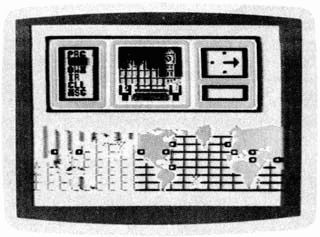Reviews
Hacker
Todd Heimarck, Assistant Editor
Requirements: Commodore 64 or 128; Apple II-series computer with at least 64K RAM; Atari 400/800, XL, or XE with at least 48K RAM; IBM PC/PCjr with at least 128K RAM; Atari ST; Amiga; or Apple Macintosh. Disk only.
When the first thing you see is the prompt LOGON PLEASE:, you want to reach for the rule book. But apart from a card that tells you how to load and run this game, there are no instructions. None at all.
The premise behind Hacker is that you have stumbled across a telecommunications system about which you know nothing. Being a good hacker (if that's not an oxymoron), you feel the urge to break in and explore. Try a few passwords; unless you're very lucky, none of them will work. After several failures, the system logs you off and the game ends. Or does it? Some random characters appear on the screen, and the computer indicates that a security malfunction has occurred. You're in.

On the trail of corporate skullduggery in
Activision's Hacker (Commodore 64 version).
The logon sequence is very realistic. Once, at the beginning of a game, someone walked into the room and watched me guess at a few passwords. Hearing that we were trying to get into an unknown system, which might be a government computer, and then seeing the security malfunction message, he got worried and reminded us that it's illegal to do what we were doing. That's the great appeal of Hacker, the feeling that you're doing something wrong and that you might get caught. Who knows, the FBI might even show up at your door and confiscate your computer.
After you enter the system, the game becomes less realistic. On an actual telecommunications system, everything would be straight text. The author of Hacker, in the interests of playability, has inserted some high-resolution graphics-unlike anything you'd see on a true bulletin board system or information service. However, the graphics do add a lot to the game.
Remote-Control Robots
You soon discover that you've come across a company involved in some sort of top-secret illegal project. This makes you feel less guilty about breaking into someone's system; you can seek out more information about this project and bring the culprits to justice.
The company owns a vast network of subterranean tunnels, and their computer (to which you've gained access) controls robots that travel through the tunnels. By using the robot to explore the tunnel network and occasionally coming to the surface, you can accumulate more details about the project. I'll say no more about the most effective techniques for winning because an important part of the game is figuring out what's going on.
The game play is almost identical in the versions I tried on the Commodore 64, Atari 520ST, and Amiga. The newer 16-bit machines (Amiga and ST) displayed slightly better graphics than the 64 because their screens have higher resolution and more colors. The ST version works on both monochrome and color monitors.
All things considered, Hacker is a worthy addition to your software collection, especially if you enjoy adventure games that require a bit of thought and an investment of time.
Hacker
Activision, Inc.
2350 Bayshore Frontage Road
Mountain View, CA 94043
$24.95 (Atari 400/800/XL/XE)
$29.95 (Commodore 64/128)
$39.95 (Apple and IBM)
$44.95 (ST, Amiga, and Macintosh)